steering YAMAHA MT-10 2020 Owners Manual
[x] Cancel search | Manufacturer: YAMAHA, Model Year: 2020, Model line: MT-10, Model: YAMAHA MT-10 2020Pages: 108, PDF Size: 9.22 MB
Page 6 of 108

Table of contentsSafety information........................... 1-1
Description ....................................... 2-1
Left view ......................................... 2-1
Right view ....................................... 2-2
Controls and instruments................ 2-3
Special features ............................... 3-1
Cruise control system ..................... 3-1
D-mode (drive mode)...................... 3-3
Traction control system .................. 3-4
Quick shift system ...... .................... 3-6
Instrument and control
functions ........................................... 4-1
Immobilizer system ..... .................... 4-1
Main switch/steering lock................ 4-2
Handlebar switches ........................ 4-3
Indicator lights and warning lights ............................................ 4-5
Multi-function meter unit ................. 4-8
Clutch lever................................... 4-16
Shift pedal..... ............................ .... 4-16
Brake lever ................................... 4-16
Brake pedal .................................. 4-17
ABS .............................................. 4-17
Fuel tank cap ................................ 4-18
Fuel............................................... 4-19
Fuel tank overflow hose................ 4-21
Catalytic converter ........................ 4-21
Seat .............................................. 4-22 Adjusting the front fork ................. 4-22
Adjusting the shock absorber
assembly................................... 4-24
Luggage strap holders . ................ 4-27
EXUP system ............................... 4-27
Auxiliary DC jack .......................... 4-27
Sidestand ..................................... 4-28
Ignition circuit cut- off system ........ 4-29
For your safety – pre-operation
checks .............................................. 5-1
Operation and important riding
points ................................................ 6-1
Starting the engine ......................... 6-1
Shifting ........................................... 6-2
Tips for reducing fuel consumption ............................... 6-3
Engine break-in .............................. 6-3
Parking ........................................... 6-4
Periodic maintenance and
adjustment ....................................... 7-1
Tool kit............................................ 7-2
Periodic maintenance charts .......... 7-3
Periodic maintenance chart for the emission control system ....... 7-3
General maintenance and
lubrication chart .......................... 7-5
Checking the spark plugs ............... 7-9
Canister ........................................ 7-10 Engine oil ..................................... 7-10
Why Yamalube ............................ 7-14
Coolant ........................................ 7-14
Air filter element ........................... 7-15
Checking the engine idling
speed............ ............................ 7-16
Checking the throttle grip free play ........................................... 7-16
Valve clearance ........................... 7-16
Tires ............................................. 7-17
Cast wheels ................................. 7-19
Adjusting the clutch lever free play ........................................... 7-19
Checking the brake lever free
play ........................................... 7-20
Brake light switches ..................... 7-21
Checking the front and rear
brake pads................................ 7-21
Checking the brake fluid level ...... 7-22
Changing the brake fluid .............. 7-23
Drive chain slack.......................... 7-23
Cleaning and lubricating the drive chain ................................ 7-24
Checking and lubricating the cables ....................................... 7-25
Checking and lubricating the throttle grip and cable ............... 7-25
Checking and lubricating the
brake and shift pedals .............. 7-26
Checking and lubricating the brake and clutch levers ............ 7-26B67-9-E4.book 1 ページ 2019年7月19日 金曜日 午後4時23分
Page 7 of 108

Table of contents
Checking and lubricating the sidestand................................... 7-27
Lubricating the swingarm pivots......................................... 7-27
Checking the front fork ................. 7-28
Checking the steering . .................. 7-28
Checking the wheel bearings ....... 7-29
Battery .......................................... 7-29
Replacing the fuses ...................... 7-30
Vehicle lights ................................ 7-33
Supporting the motor cycle............ 7-34
Troubleshooting............................ 7-34
Troubleshooting charts ................. 7-35
Motorcycle care and storage .......... 8-1
Matte color caution ......................... 8-1
Care................................................ 8-1
Storage ........................................... 8-4
Specifications .................................. 9-1
Consumer information .................. 10-1
Identification numbers .................. 10-1
Diagnostic connector ... ................. 10-2
Vehicle data recordin g.................. 10-2
Index ............................................... 11-1
B67-9-E4.book 2 ページ 2019年7月19日 金曜日 午後4時23分
Page 10 of 108

Safety information
1-3
1
2
3
4
5
6
7
8
9
10
11
12 MENT.
Do not run engine indoors. Even if
you try to ventilate engine exhaust
with fans or open windows and
doors, carbon monoxide can rap-
idly reach dangerous levels.
Do not run engine in poorly venti-
lated or partially enclosed areas
such as barns, garages, or car-
ports.
Do not run engine outdoors where
engine exhaust can be drawn into
a building through openings such
as windows and doors.
Loading
Adding accessories or cargo to your
motorcycle can adversely affect stabili-
ty and handling if the weight distribution
of the motorcycle is changed. To avoid
the possibility of an accident, use ex-
treme caution when adding cargo or
accessories to your motorcycle. Use
extra care when riding a motorcycle
that has added cargo or accessories.
Here, along with the information about
accessories below, are some general
guidelines to follow if loading cargo to
your motorcycle: The total weight of the operator, pas-
senger, accessories and cargo must
not exceed the maximum load limit.
Operation of an overloaded vehicle
could cause an accident.
When loading within this weight limit,
keep the following in mind:
Cargo and accessory weight
should be kept as low and close to
the motorcycle as possible. Se-
curely pack your heaviest items as
close to the center of the vehicle as
possible and make sure to distrib-
ute the weight as evenly as possi-
ble on both sides of the motorcycle
to minimize imbalance or instabili-
ty.
Shifting weights can create a sud-
den imbalance. Make sure that ac-
cessories and cargo are securely
attached to the motorcycle before
riding. Check accessory mounts
and cargo restraints frequently.
Properly adjust the suspension
for your load (suspension-ad- justable models only), and
check the condition and pres-
sure of your tires.
Never attach any large or heavy items to the handlebar, front
fork, or front fender. These
items, including such cargo as
sleeping bags, duffel bags, or
tents, can create unstable han-
dling or a slow steering re-
sponse.
This vehicle is not designed to
pull a trailer or to be attached to
a sidecar.
Genuine Yamaha Accessories
Choosing accessories for your vehicle
is an important decision. Genuine
Yamaha accessories, which are avail-
able only from a Yamaha dealer, have
been designed, tested, and approved
by Yamaha for use on your vehicle.
Many companies with no connection to
Yamaha manufacture parts and acces-
sories or offer other modifications for
Yamaha vehicles. Yamaha is not in a
position to test the products that these
aftermarket companies produce.
Therefore, Yamaha can neither en-
Maximum load: 170 kg (375 lb)
B67-9-E4.book 3 ページ 2019年7月19日 金曜日 午後4時23分
Page 11 of 108
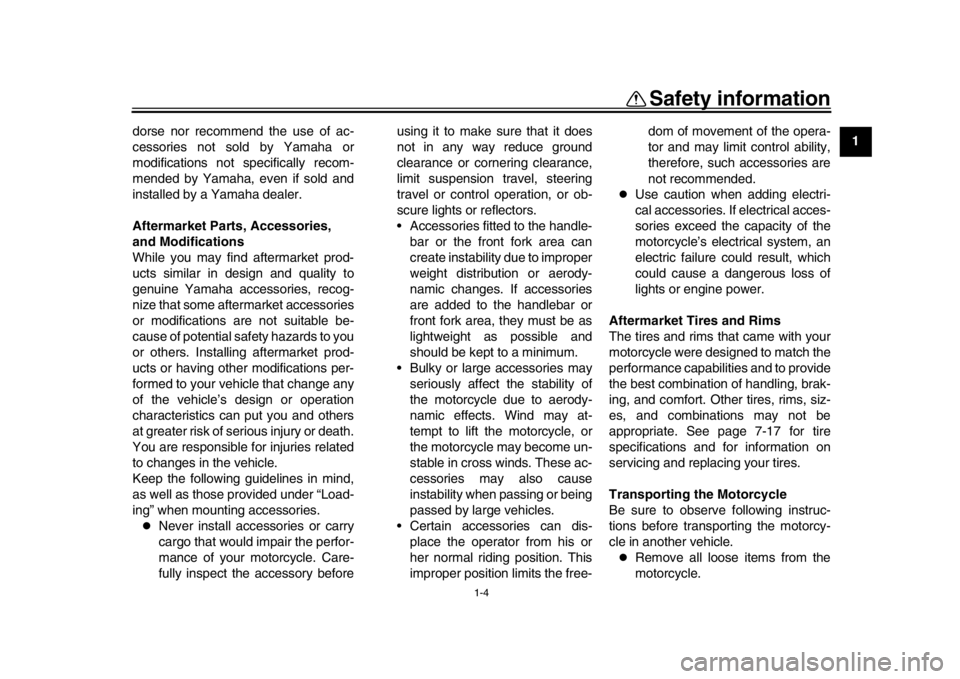
Safety information
1-4
12
3
4
5
6
7
8
9
10
11
12
dorse nor recommend the use of ac-
cessories not sold by Yamaha or
modifications not specifically recom-
mended by Yamaha, even if sold and
installed by a Yamaha dealer.
Aftermarket Parts, Accessories,
and Modifications
While you may find aftermarket prod-
ucts similar in design and quality to
genuine Yamaha accessories, recog-
nize that some aftermarket accessories
or modifications are not suitable be-
cause of potential safety hazards to you
or others. Installing aftermarket prod-
ucts or having other modifications per-
formed to your vehicle that change any
of the vehicle’s design or operation
characteristics can put you and others
at greater risk of serious injury or death.
You are responsible for injuries related
to changes in the vehicle.
Keep the following guidelines in mind,
as well as those provided under “Load-
ing” when mounting accessories.
Never install accessories or carry
cargo that would impair the perfor-
mance of your motorcycle. Care-
fully inspect the accessory before using it to make sure that it does
not in any way reduce ground
clearance or cornering clearance,
limit suspension travel, steering
travel or control operation, or ob-
scure lights or reflectors.
Accessories fitted to the handle-
bar or the front fork area can
create instability due to improper
weight distribution or aerody-
namic changes. If accessories
are added to the handlebar or
front fork area, they must be as
lightweight as possible and
should be kept to a minimum.
Bulky or large accessories may seriously affect the stability of
the motorcycle due to aerody-
namic effects. Wind may at-
tempt to lift the motorcycle, or
the motorcycle may become un-
stable in cross winds. These ac-
cessories may also cause
instability when passing or being
passed by large vehicles.
Certain accessories can dis- place the operator from his or
her normal riding position. This
improper position limits the free- dom of movement of the opera-
tor and may limit control ability,
therefore, such accessories are
not recommended.
Use caution when adding electri-
cal accessories. If electrical acces-
sories exceed the capacity of the
motorcycle’s electrical system, an
electric failure could result, which
could cause a dangerous loss of
lights or engine power.
Aftermarket Tires and Rims
The tires and rims that came with your
motorcycle were designed to match the
performance capabilities and to provide
the best combination of handling, brak-
ing, and comfort. Other tires, rims, siz-
es, and combinations may not be
appropriate. See page 7-17 for tire
specifications and for information on
servicing and replacing your tires.
Transporting the Motorcycle
Be sure to observe following instruc-
tions before transporting the motorcy-
cle in another vehicle.
Remove all loose items from the
motorcycle.
B67-9-E4.book 4 ページ 2019年7月19日 金曜日 午後4時23分
Page 15 of 108
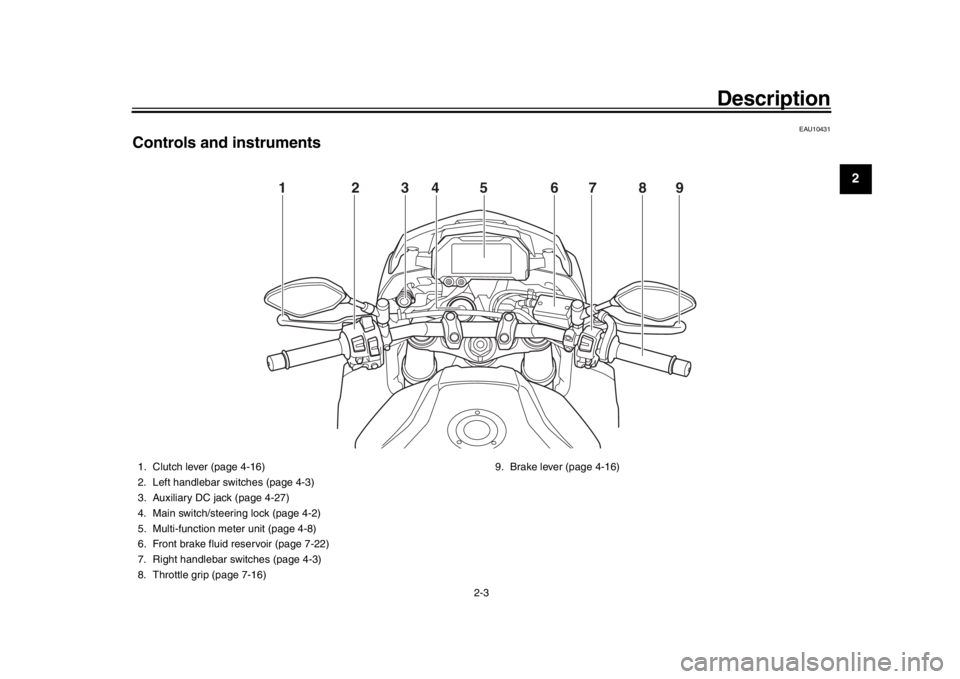
Description
2-3
123
4
5
6
7
8
9
10
11
12
EAU10431
Controls and instruments
12 456789
3
1. Clutch lever (page 4-16)
2. Left handlebar switches (page 4-3)
3. Auxiliary DC jack (page 4-27)
4. Main switch/steering lock (page 4-2)
5. Multi-function meter unit (page 4-8)
6. Front brake fluid reservoir (page 7-22)
7. Right handlebar switches (page 4-3)
8. Throttle grip (page 7-16) 9. Brake lever (page 4-16)
B67-9-E4.book 3 ページ 2019年7月19日 金曜日 午後4時23分
Page 23 of 108
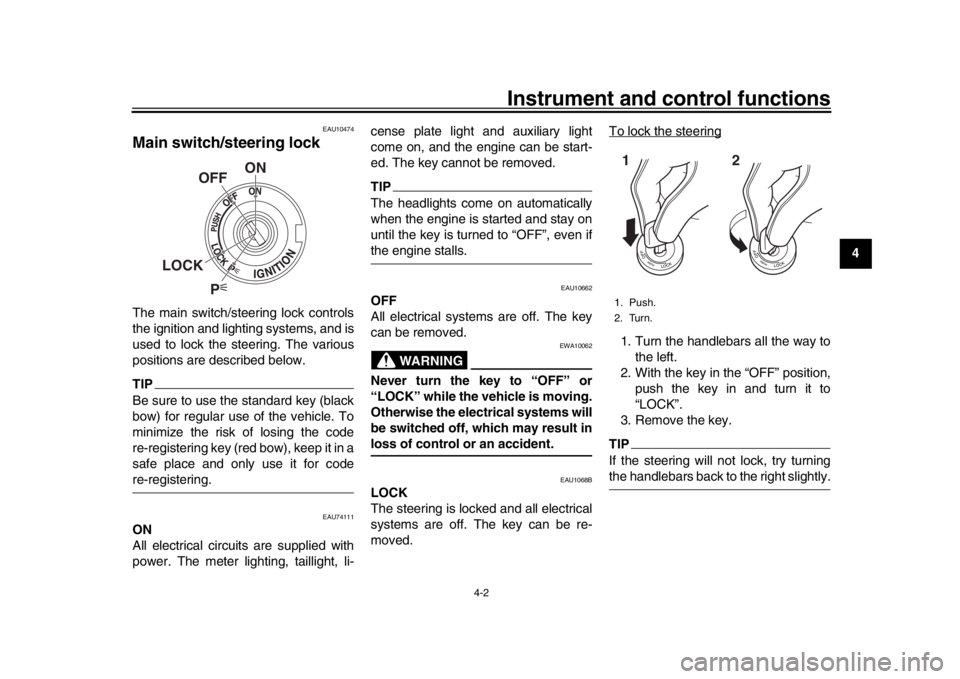
Instrument and control functions
4-2
1
2
345
6
7
8
9
10
11
12
EAU10474
Main switch/steering lockThe main switch/steering lock controls
the ignition and lighting systems, and is
used to lock the steering. The various
positions are described below.TIPBe sure to use the standard key (black
bow) for regular use of the vehicle. To
minimize the risk of losing the code
re-registering key (red bow), keep it in a
safe place and only use it for codere-registering.
EAU74111
ON
All electrical circuits are supplied with
power. The meter lighting, taillight, li- cense plate light and auxiliary light
come on, and the engine can be start-
ed. The key cannot be removed.
TIPThe headlights come on automatically
when the engine is started and stay on
until the key is turned to “OFF”, even ifthe engine stalls.
EAU10662
OFF
All electrical systems are off. The key
can be removed.
WARNING
EWA10062
Never turn the key to “OFF” or
“LOCK” while the vehicle is moving.
Otherwise the electrical systems will
be switched off, which may result inloss of control or an accident.
EAU1068B
LOCK
The steering is locked and all electrical
systems are off. The key can be re-
moved.
To lock the steering
1. Turn the handlebars all the way to
the left.
2. With the key in the “OFF” position, push the key in and turn it to
“LOCK”.
3. Remove the key.TIPIf the steering will not lock, try turningthe handlebars back to the right slightly.
P
ON
OFF
LOCK
1. Push.
2. Turn.12
B67-9-E4.book 2 ページ 2019年7月19日 金曜日 午後4時23分
Page 24 of 108
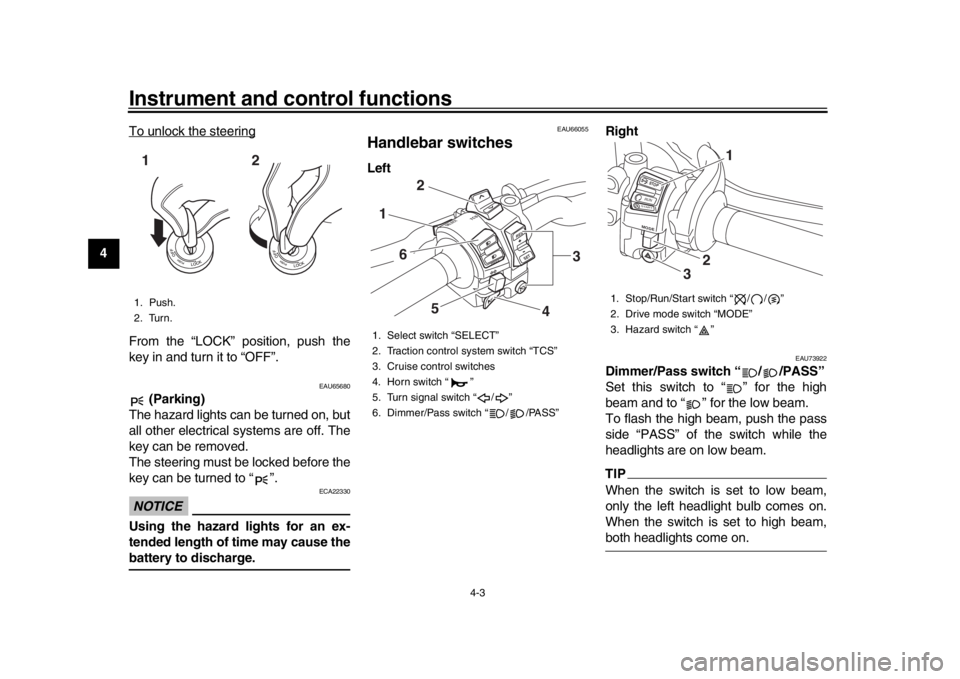
Instrument and control functions
4-3
1
2
34
5
6
7
8
9
10
11
12 To unlock the steering
From the “LOCK” position, push the
key in and turn it to “OFF”.
EAU65680
(Parking)
The hazard lights can be turned on, but
all other electrical systems are off. The
key can be removed.
The steering must be locked before the
key can be turned to “ ”.NOTICE
ECA22330
Using the hazard lights for an ex-
tended length of time may cause thebattery to discharge.
EAU66055
Handlebar switchesLeft Right
EAU73922
Dimmer/Pass switch “ / /PASS”
Set this switch to “ ” for the high
beam and to “ ” for the low beam.
To flash the high beam, push the pass
side “PASS” of the switch while the
headlights are on low beam.TIPWhen the switch is set to low beam,
only the left headlight bulb comes on.
When the switch is set to high beam,both headlights come on.
1. Push.
2. Turn.12
1. Select switch “SELECT”
2. Traction control system switch “TCS”
3. Cruise control switches
4. Horn switch “ ”
5. Turn signal switch “ / ”
6. Dimmer/Pass switch “ / /PASS”
R
ESSE T
PAS
S
TCS
SELECT
1
6
5
4
2
3
1. Stop/Run/Start switch “ / / ”
2. Drive mode switch “MODE”
3. Hazard switch “ ”
STOPMODERUNSTA R T
3
2
1
B67-9-E4.book 3 ページ 2019年7月19日 金曜日 午後4時23分
Page 26 of 108
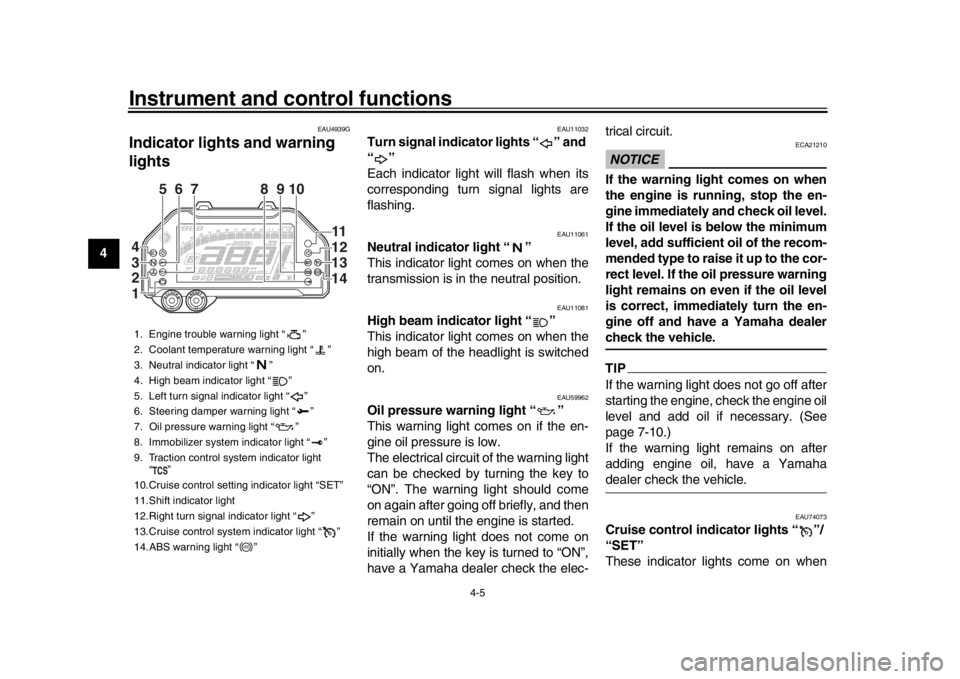
Instrument and control functions
4-5
1
2
34
5
6
7
8
9
10
11
12
EAU4939G
Indicator ligh ts and warning
lights
EAU11032
Turn signal indicator lights “ ” and
“”
Each indicator light will flash when its
corresponding turn signal lights are
flashing.
EAU11061
Neutral indicator light “ ”
This indicator light comes on when the
transmission is in the neutral position.
EAU11081
High beam indicator light “ ”
This indicator light comes on when the
high beam of the headlight is switched
on.
EAU59962
Oil pressure warning light “ ”
This warning light comes on if the en-
gine oil pressure is low.
The electrical circuit of the warning light
can be checked by turning the key to
“ON”. The warning light should come
on again after going off briefly, and then
remain on until the engine is started.
If the warning light does not come on
initially when the key is turned to “ON”,
have a Yamaha dealer check the elec- trical circuit.
NOTICE
ECA21210
If the warning light comes on when
the engine is running, stop the en-
gine immediately and check oil level.
If the oil level is below the minimum
level, add sufficient oil of the recom-
mended type to raise it up to the cor-
rect level. If the oil pressure warning
light remains on even if the oil level
is correct, immediately turn the en-
gine off and have a Yamaha dealercheck the vehicle.TIPIf the warning light does not go off after
starting the engine, check the engine oil
level and add oil if necessary. (See
page 7-10.)
If the warning light remains on after
adding engine oil, have a Yamahadealer check the vehicle.
EAU74073
Cruise control indicator lights “ ”/
“SET”
These indicator lights come on when
1. Engine trouble warning light “ ”
2. Coolant temperature warning light “ ”
3. Neutral indicator light “ ”
4. High beam indicator light “ ”
5. Left turn signal indicator light “ ”
6. Steering damper warning light “ ”
7. Oil pressure warning light “ ”
8. Immobilizer system indicator light “ ”
9. Traction control system indicator light
“”
10.Cruise control setting indicator light “SET”
11.Shift indicator light
12.Right turn signal indicator light “ ”
13.Cruise control system indicator light “ ”
14.ABS warning light “ ”
567 9 810
11
12
13
14
4
3
2
1
ABS
B67-9-E4.book 5 ページ 2019年7月19日 金曜日 午後4時23分
Page 28 of 108
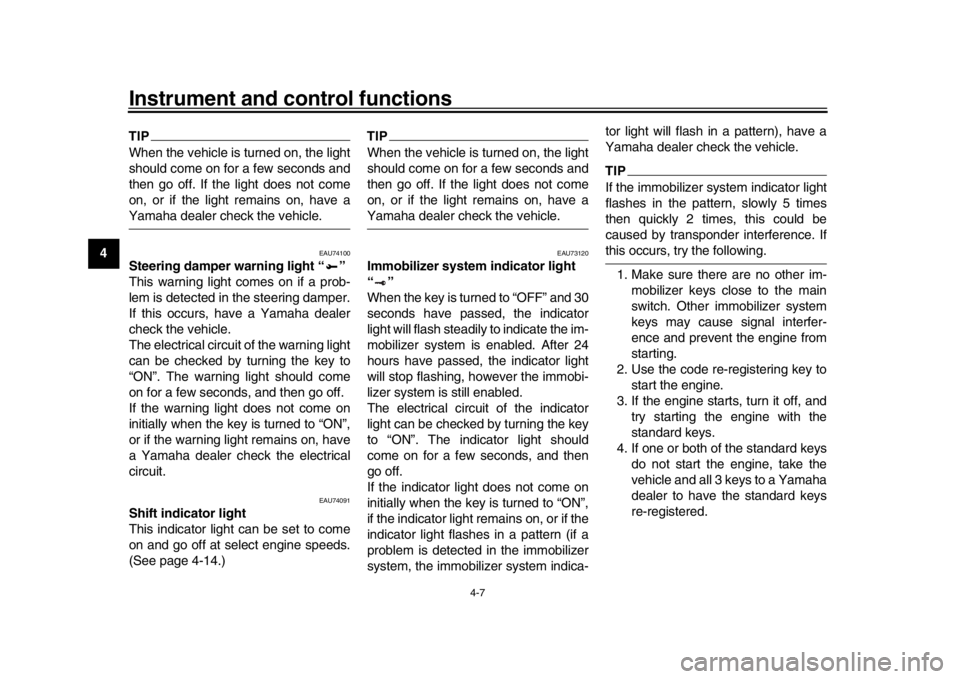
Instrument and control functions
4-7
1
2
34
5
6
7
8
9
10
11
12
TIPWhen the vehicle is turned on, the light
should come on for a few seconds and
then go off. If the light does not come
on, or if the light remains on, have aYamaha dealer check the vehicle.
EAU74100
Steering damper warning light “ ”
This warning light comes on if a prob-
lem is detected in the steering damper.
If this occurs, have a Yamaha dealer
check the vehicle.
The electrical circuit of the warning light
can be checked by turning the key to
“ON”. The warning light should come
on for a few seconds, and then go off.
If the warning light does not come on
initially when the key is turned to “ON”,
or if the warning light remains on, have
a Yamaha dealer check the electrical
circuit.
EAU74091
Shift indicator light
This indicator light can be set to come
on and go off at select engine speeds.
(See page 4-14.)
TIPWhen the vehicle is turned on, the light
should come on for a few seconds and
then go off. If the light does not come
on, or if the light remains on, have aYamaha dealer check the vehicle.
EAU73120
Immobilizer system indicator light
“”
When the key is turned to “OFF” and 30
seconds have passed, the indicator
light will flash steadil y to indicate the im-
mobilizer system is enabled. After 24
hours have passed, the indicator light
will stop flashing, however the immobi-
lizer system is still enabled.
The electrical circuit of the indicator
light can be checked by turning the key
to “ON”. The indicator light should
come on for a few seconds, and then
go off.
If the indicator light does not come on
initially when the key is turned to “ON”,
if the indicator light remains on, or if the
indicator light flashes in a pattern (if a
problem is detected in the immobilizer
system, the immobilizer system indica- tor light will flash in a pattern), have a
Yamaha dealer check the vehicle.
TIPIf the immobilizer system indicator light
flashes in the pattern, slowly 5 times
then quickly 2 times, this could be
caused by transponder interference. Ifthis occurs, try the following.
1. Make sure there are no other im- mobilizer keys close to the main
switch. Other immobilizer system
keys may cause signal interfer-
ence and prevent the engine from
starting.
2. Use the code re-registering key to start the engine.
3. If the engine starts, turn it off, and try starting the engine with the
standard keys.
4. If one or both of the standard keys do not start the engine, take the
vehicle and all 3 keys to a Yamaha
dealer to have the standard keys
re-registered.
B67-9-E4.book 7 ページ 2019年7月19日 金曜日 午後4時23分
Page 55 of 108
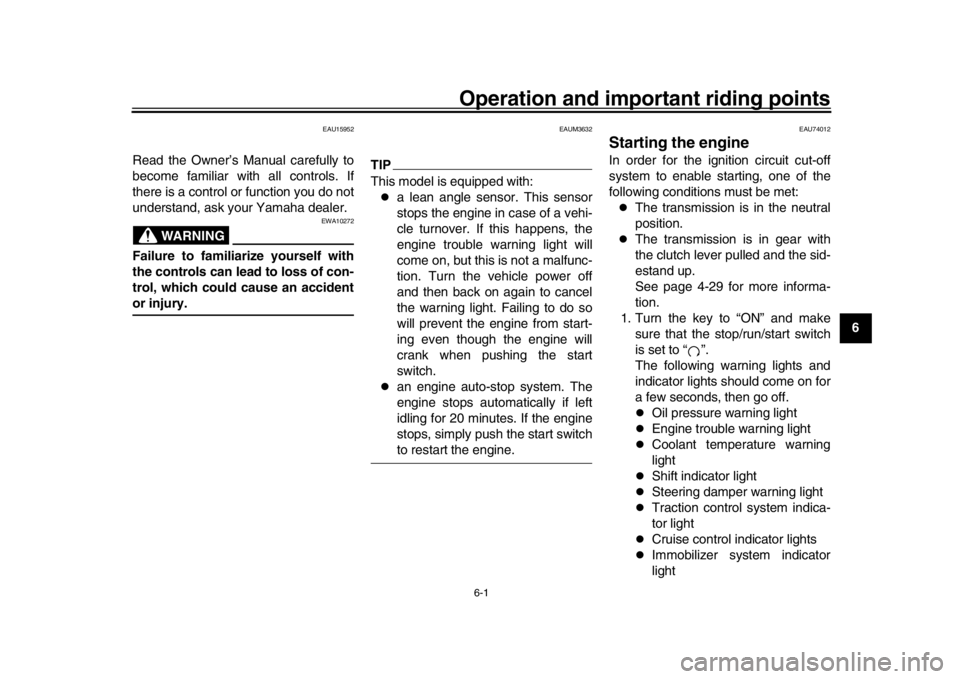
6-1
1
2
3
4
567
8
9
10
11
12
Operation and important riding points
EAU15952
Read the Owner’s Manual carefully to
become familiar with all controls. If
there is a control or function you do not
understand, ask your Yamaha dealer.
WARNING
EWA10272
Failure to familiarize yourself with
the controls can lead to loss of con-
trol, which could cause an accidentor injury.
EAUM3632
TIPThis model is equipped with:
a lean angle sensor. This sensor
stops the engine in case of a vehi-
cle turnover. If this happens, the
engine trouble warning light will
come on, but this is not a malfunc-
tion. Turn the vehicle power off
and then back on again to cancel
the warning light. Failing to do so
will prevent the engine from start-
ing even though the engine will
crank when pushing the start
switch.
an engine auto-stop system. The
engine stops automatically if left
idling for 20 minutes. If the engine
stops, simply push the start switchto restart the engine.
EAU74012
Starting the engineIn order for the ignition circuit cut-off
system to enable starting, one of the
following conditions must be met:
The transmission is in the neutral
position.
The transmission is in gear with
the clutch lever pulled and the sid-
estand up.
See page 4-29 for more informa-
tion.
1. Turn the key to “ON” and make sure that the stop/run/start switch
is set to “ ”.
The following warning lights and
indicator lights should come on for
a few seconds, then go off.
Oil pressure warning light
Engine trouble warning light
Coolant temperature warning
light
Shift indicator light
Steering damper warning light
Traction control system indica-
tor light
Cruise control indicator lights
Immobilizer system indicator
light
B67-9-E4.book 1 ページ 2019年7月19日 金曜日 午後4時23分